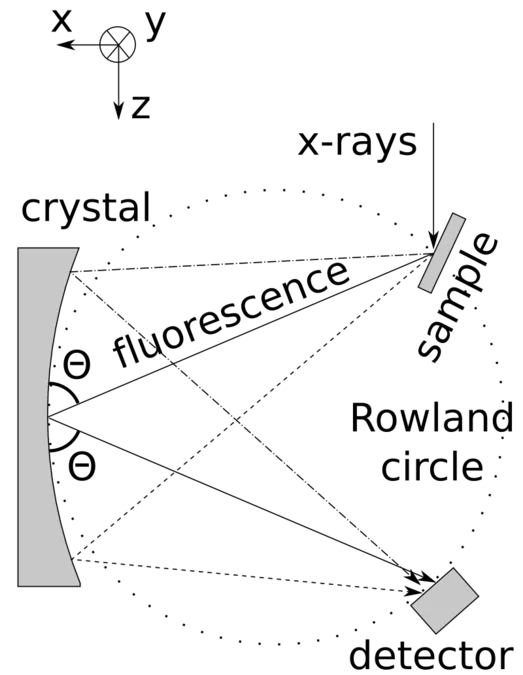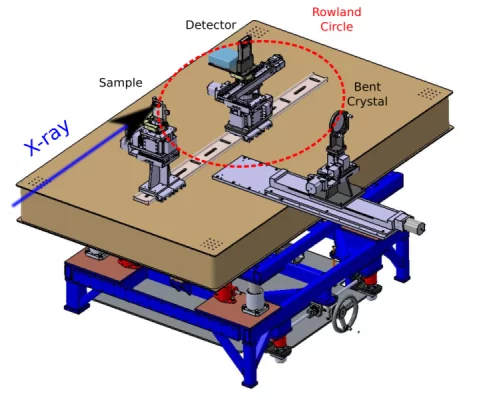Status
Done: The 5-crystal Johann-type spectrometer is available only on request. It is necessary to contact beamline scientist before proposal submission
Done: The (old) 1-crystal Johann-type spectrometer is available only on request
Publications
- Five-element Johann-type X-ray emission spectrometer with a single-photon-counting pixel detector, E. Kleymenov, J. van Bokhoven, C. David, P. Glatzel, J. Markus, R. Alonso-Mori, M. Studer, M. Willimann, A. Bergamaschi, B. Henrich, M. Nachtegaal, Review of Scientific Instruments 82, 065107 (2011)
- High- resolution hard-X-ray fluorescence spectrometer, E. Kleimenov, A. Bergamaschi, J. van Bokhoven, M. Janousch, B. Schmitt, M. Nachtegaal, JOURNAL OF PHYSICS: CONFERENCE SERIES 190, 012035 (2009)
General description
Fluorescence spectrometer can be used for such techniques as X-ray emission spectroscopy (XES), high-energy-resolution fluorescence-detected (HERFD) XAS, resonant inelastic X-ray scattering (RIXS), and X-ray Raman spectroscopy (XRS).
The spectrometer consists of a spherically-curved X-ray crystal and X-ray detector. The crystal reflects the X-ray radiation of a certain wavelength, which satisfies the Bragg law. The wavelength depends on the incident (Bragg) angle, which can be scanned by changing the positions of the crystal and detector. The resolution of the spectrometer (bandwidth of the reflected radiation) depends on the Bragg angle. The best resolution is obtained at the angles close to 90 degree (backscattering). The maximum Bragg angle, which can be reached with the current design of spectrometer is approximately 85 degree. One type of crystal covers a range of few hundred eV. See the list of available crystals below.
Two spectrometers are available at the beamline: one-crystal (old) and five-crystal (new). Currently, the one-crystal spectrometer is used only for special experiment arrangements, which require detection of emitted radiation in the horizontal plane. For all the other experiments please consider using the five-crystal spectrometer. The "five-crystal" spectrometer can be operated with one, two, three, four or five crystals.
X-ray detectors for the X-ray emission spectrometers
MYTHEN II
MYTHEN II detector is developed in the Paul Scherrer Institute. It is a position-sensitive micro-strip silicon detector. The detector element consists of 1280 strips of a size of 0.05 x 8 mm2. The detector is operated in the energy-thresholded photon-counting mode. A MYTHEN module is available at the beamline for use with the one-crystal or five-crystal spectrometer.
PILATUS 100K
PILATUS 100K is a 2D pixel detector with a pixel size of 0.172 x 0.172 mm2 developed at the Paul Scherrer Institute. The detector is operated in the energy-thresholded photon-counting mode. A PILATUS 100K module from the SLS detector pool is available for use with the five-crystal spectrometer.
Crystals available
Below is the list of the available crystals and energy ranges corresponding to different diffraction orders. The list can be not up to date. Please contact the beamline scientist for the actual information.
The crystal diameter is 10 cm (+/- 2 mm). The radius of curvature is 1 m (+/- 3 mm).
Users are welcome to bring their own crystals for their experiment.
Si(111) - 6 crystals
| h | k | l | E(theta=90 deg)/keV | E(theta=60 deg)/keV | Comment |
|---|---|---|---|---|---|
| 3 | 3 | 3 | 5.931 | 6.849 | |
| 4 | 4 | 4 | 7.908 | 9.132 | Cu Ka |
| 5 | 5 | 5 | 9.885 | 11.415 | |
| 7 | 7 | 7 | 13.839 | 15.980 | |
| 8 | 8 | 8 | 15.817 | 18.263 | |
| 9 | 9 | 9 | 17.794 | 20.546 |
Si(733) - 1 crystal
| h | k | l | E(theta=90 deg)/keV | E(theta=60 deg)/keV | Comment |
|---|---|---|---|---|---|
| 7 | 3 | 3 | 9.343 | 10.789 | Pt La, Au La |
Ge(111) - 1 crystal
| h | k | l | E(theta=90 deg)/keV | E(theta=60 deg)/keV | Comment |
|---|---|---|---|---|---|
| 3 | 3 | 3 | 5.693 | 6.574 | |
| 4 | 4 | 4 | 7.591 | 8.765 | |
| 5 | 5 | 5 | 9.489 | 10.957 | |
| 7 | 7 | 7 | 13.284 | 15.339 | |
| 8 | 8 | 8 | 15.182 | 17.530 | |
| 9 | 9 | 9 | 17.080 | 19.722 |
Ge(100) - 1 crystal
| h | k | l | E(theta=90 deg)/keV | E(theta=60 deg)/keV | Comment |
|---|---|---|---|---|---|
| 4 | 0 | 0 | 4.383 | 5.061 | |
| 8 | 0 | 0 | 8.765 | 10.121 | Cu Kb |
Ge(331) - 1 crystal
| h | k | l | E(theta=90 deg)/keV | E(theta=60 deg)/keV | Comment |
|---|---|---|---|---|---|
| 3 | 3 | 1 | 4.776 | 5.515 | Ce La1 |
Si(211) - 1 crystal
| h | k | l | E(theta=90 deg)/keV | E(theta=60 deg)/keV | Comment |
|---|---|---|---|---|---|
| 4 | 2 | 2 | 5.592 | 6.457 | Ce Lb2 |
Si(531) - 1 crystal
| h | k | l | E(theta=90 deg)/keV | E(theta=60 deg)/keV | Comment |
|---|---|---|---|---|---|
| 5 | 3 | 1 | 6.753 | 7.798 | Fe Kb |




